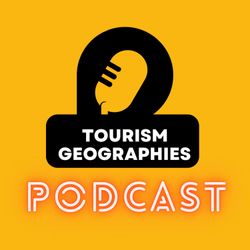Latest episode

14. Geographies of hotel guest electricity, water and gas consumption
27:17||Season 4, Ep. 14https://doi.org/10.1080/14616688.2025.2516098AbstractIndividual preferences are known to be influenced by people’s lived experience at home and on holidays, however, the factors contributing to higher or lower resource demands by hotel guests are not well understood. We advance a practice-based ‘Resource Cultures’ framework and examine the daily energy and water consumption rates of hotel guests from geographically diverse climates vacationing at a ecolodge in tropical North Queensland, Australia. Specifically, guests’ (n = 395) ‘home’ climate zone and continental origin, as a proxy for cultural background, are examined as potential drivers of resource consumption. The results show that climatic origin is a stronger determinant of resource use than cultural origin. Guests originating from tropical and arid climate zones used significantly more water and energy than those from warm temperate zones. Electricity consumption was highest among guests from humid tropical and subtropical climate zones, whilst those from arid climate zones used the most water. The findings provide empirical evidence of the influence of origin-related drivers of resource consumption patterns with tangible implications for accommodation providers. Considering guests’ climatic and cultural origins in targeted pro-environmental communication will enhance the effectiveness of operators’ sustainability programs. Furthermore, these factors should be considered when benchmarking resource use among comparable hotels.
More episodes
View all episodes

13. From project to venture: facilitating engagement and entrepreneurship in rural tourism
26:44||Season 4, Ep. 13https://doi.org/10.1080/14616688.2025.2519331AbstractProjects are a standard strategy for rural tourism development. This study builds on the premise that sustainable rural tourism is conditioned by the involvement of key stakeholders and entrepreneurs’ ability to creatively and responsibly utilise local resources for tourism purposes. Accordingly, this research explores the project format as a framework for facilitating engagement and entrepreneurship. The empirical context is Visit Village, a collaborative tourism initiative in rural Sweden. This qualitative case study has followed the Visit Village project closely for nearly three years. Data was collected from observations, reviewing documents, in-depth interviews, and informal conversations. The analysis focused on the actors involved in the project, their respective roles, and the interactions between them. This study applies the Civic Wealth Creation (CWC) theoretical framework for stakeholder engagement. The framework directs the analysis to the meso level of the entrepreneurial ecosystems, where interactions generate value and promote positive social impact. The findings indicate that projects can be a fruitful setting for entrepreneurship by providing access to resources, knowledge, and support and forming communities and creative spaces; concurrently, the findings corroborate the difficulty of involving key stakeholders. The intricacy seems to lie in the incompatibility of the project format and the modus operandi of small-scale entrepreneurs and the local community. The analysis suggests generating a sense of progression, kinship, and ownership to adjust the project to the stakeholders’ logic of action. Owner-managers of local tourism businesses emerge as natural CWC promoters, and the study recommends entrusting embedded and entrepreneurial individuals with formal responsibilities in tourism projects. The analysis also underlines the need for project leaders to redefine their roles throughout the process.
12. Lifestyle migration and the emergence of ‘Airbnburbs’ in the Global South
24:33||Season 4, Ep. 12https://doi.org/10.1080/14616688.2025.2504039AbstractAirbnb research has focused primarily on a small number of Western countries. This study examines Airbnb and its hosts in a destination in the Global South—Bocas del Toro, Panama. Through an exploration of the nexus between Airbnb hosting and lifestyle migration, the study introduces the phenomenon of ‘Airbnburbs’—new geographical spaces shaped by external property investment, situated outside major population or touristic centres, and characterized by a plethora of short-term rentals. The research entailed a descriptive case study with two parts. The first part involved analysing the growth and current footprint of Airbnb in Bocas del Toro. Next, interviews with twenty local Airbnb hosts were conducted to investigate their motivations, experiences, and perceived impacts. The findings show that Airbnb has expanded quickly throughout Bocas del Toro, particularly in areas beyond traditional tourist centres. Interviews found that younger hosts were motivated to use Airbnb primarily to minimize work hours and facilitate their desired lifestyles. Hosts also tended to concentrate in ‘Airbnburbs’, often developed by converting forested land into foreign-owned enclaves. Such neighbourhoods were largely controlled by lifestyle migrant entrepreneurs to suit their lifestyle and income demands, while generally failing to create income-generating opportunities for locals. This research suggests ways these spaces might become more inclusive and proposes new areas for future research.
11. Crafting destination stories: enacting and sharing cultural memory for Indigenous tourism
21:12||Season 4, Ep. 11https://doi.org/10.1080/14616688.2025.2495175AbstractCultural memory, which shapes a collective understanding of historical experiences and influences identity, is crucial in the Indigenous context but has been understudied in tourism. This study examines the role of the Guthi system, a cultural space of Indigenous Newars from Khokana, Nepal, in the construction and sustenance of cultural memory across time and location. Employing a multi-phased qualitative approach, the study reveals how the Guthi system, rooted in the Indigenous Newars’ relational ontologies, integrates spiritual, cultural, and societal elements into a living archive of traditions and practices. The findings elucidate the processes of enacting and sharing cultural memory, demonstrating its impact on collective sensemaking within Indigenous tourism contexts. Moreover, the study identifies key factors influencing this process, including adaptive preferences, path dependence, and Indigenous values, which shape community engagement with tourism opportunities. This novel contribution to Indigenous tourism research illuminates the intricate relationship between cultural memory, collective sensemaking, and the translation of Indigenous knowledge and practices into tourism initiatives.
10. Space tourism and sustainable trajectory
22:38||Season 4, Ep. 10https://www.tandfonline.com/doi/full/10.1080/14616688.2025.2525815AbstractThe commercial spaceflight industry is progressing rapidly. Yet, there is a lack of research theorising what the spatio-temporal contours of sustainability look like if the biosphere, along with its finite resources and limited ability to sustain continued population growth, constitutes a boundary that can be readily transcended. Informed by the concept of sustainable trajectory, this paper presents a conceptual model that extends the traditional spatial (e.g. national, global) and temporal (e.g. near future, intergenerational) scales that sustainability discourses in geography are typically predicated upon. We conducted a critical narrative literature review to analyse the implications of space tourism in the context of sustainable trajectory. Our analysis highlights deep tensions between the perspectives of sustainability typically promulgated in academic spheres and the path dependencies currently being formed by private spaceflight companies.
9. The tourism-migration nexus: working holiday visa politics and repurposing tourists as labour
29:08||Season 4, Ep. 9https://www.tandfonline.com/doi/full/10.1080/14616688.2025.2506523?src=AbstractThe ‘working holiday’ model of youth mobility has evolved alongside backpacking in recent decades. Increasingly, backpackers on working holidays are seen as a potential labour source in many nations, due to the flexible and highly mobile capacity which suits much agricultural work. We discuss the evolution of Australia’s Working Holiday Maker visa program, which highlights the tensions between tourism, labour, and migration. The term ‘backpacker’ is widely used in Australia interchangeably with the ‘Working Holiday Maker’ visa, identifying both a tourist subculture and what has become an essential migrant worker cohort in horticulture and a staple part of rural tourism and economies. But their presence, and the agricultural industry’s dependence on them, manifests what we identify as a ‘tourism-migration nexus’, that is, where labour chains, tourist flows, and the complexities of bilateral government agreements influence the migration trajectories of these working visitors. We draw on scholarship across backpacking, tourism and migration, in dialogue with recent policy and government inquiries, in order to trace the evolution and changes in the Australian Working Holiday Maker visa and the implications that this has on tourist mobilities as well as longer-term migration journeys.
8. Politics of tourism in public land use management: a reflexive treatise
36:14||Season 4, Ep. 8https://www.tandfonline.com/doi/full/10.1080/14616688.2025.2516837AbstractThis paper examines the political geography of land use management in developed western economies. It explains why tourism stakeholders continue to struggle to gain legitimacy in many protected area management decisions. The reason is that the politics of public land management, in general, and protected area management, in particular, are highly polarised between well-established stakeholder coalitions that try to influence government policy, but espouse contrasting strong or weak sustainability ideologies. Tourism is a disruptive force that sits awkwardly in this dyad, neither fully belonging to nor alienated from either camp. The net result is that tourism interests are often viewed with suspicion, for while they may share much in common with other stakeholder groups, its unique needs also pose a threat to traditional, long standing inter-organisational coalitions that dominate the politics of public land management. The issue is complicated further by the diverse nature of what ‘tourism’ entails, for the range of commercial activities varies from operators with a strong ecologically based focus, through to higher impact horse and vehicular access tourism and high impact roofed accommodation, resort development and consumptive forms of tourism. As such, tourism stakeholders struggle to gain trust from other stakeholder groups in the political arena.
